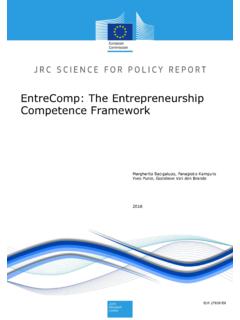Transcription of GLOBE Leadership Dimensions: Implications for Cross ...
1 11 Vol. 18, no. 2, 2018 GLOBE Leadership Dimensions: Implications for Cross -Country entrepreneurship ResearchSaurav Pathak, Kansas State University, USAE tayankara Muralidharan, MacEwan University, CanadaIntroductionThe Global entrepreneurship Monitor (GEM) survey reports that significant variance in rates of entrepreneurship exist across countries, establishing the contextually embedded nature of entrepreneurial behaviors. Only country-level factors could therefore meaningfully account for this variance. Identifying those factors then becomes the central tenet of Cross -cultural or Cross -country comparative entrepreneurship research, making it distinct from general entrepreneurship research in that the focus is mainly on understanding entrepreneurial phenomena in different contexts. It offers the benefit of generalization or modification of existing theories as well as presenting newer avenues of inquiry for research and theory development (Alon & Rottig, 2013).
2 However, several gaps still exist in this area of research. First, comparative entrepreneurship research draws predominant-ly on economic/formal institutional conditions as incentive structures for utility maximization through entrepreneurship . While the role of informal institutional conditions is gaining interest among scholars (Autio, Pathak, & Wennberg, 2013; Stephan, Uhlaner, & Stride, 2014), mechanisms through which national cultures shape entrepreneurial behaviors have not been understood fully and warrant further , entrepreneurship , as a process, has been universally viewed as an act of Leadership . But several gaps exist in our un-derstanding of the links between Leadership and entrepreneur- ship . Research has yet to find a set of specific Leadership styles that are pertinent to entrepreneurship (Cogliser & Brigham, 2004). Given that Leadership styles have also been known to be contingent upon the context within which Leadership be-haviors are performed (Antonakis & Autio, 2006), it makes them (contextually) culturally embedded too.
3 In other words, the effectiveness of Leadership styles varies across different con-textual settings different cultures, for example and has the potential to shape entrepreneurial behaviors differently across countries. We use the understanding of culturally endorsed Leadership theories (CLTs), and also draw upon theoretical and empirical insights from the Global Leadership and Organizational Be-havior Effectiveness ( GLOBE ) project (Dorfman et al., 2012), to propose future research avenues that contribute to the lit-erature exploring the role of cultural Leadership styles in influ-encing entrepreneurial behaviors across different cultures. Our attempt here is to address both of these gaps and add to extant literature that integrates Leadership and entrepreneurship re-search by introducing a cultural Leadership paradigm that ad-vances our understanding of the emergence of entrepreneurs as leaders across different PerspectivesIn this section, we discuss various theories that are relevant to understand the influences of CLTs on entrepreneurial behaviors across cultures.
4 The GLOBE study provides scores on six CLT dimensions charismatic/value-based/performance-base d, team-oriented, humane-oriented, participative, autonomous, and self-protective. The notion of CLTs in general and those of GLOBE CLTs in particular as cultural-level concepts derives from the individual-level implicit Leadership theories (ILTs). ILTs suggest that individuals hold belief systems, prototypes, or stereotypes and expectations about what constitutes good Leadership . They have assumptions and theories about the attributes of outstanding, ideal leaders that are often uncon-sciously held (Lord & Maher, 1991) and shaped by cultural 12 AIB insightsvalues. Cultures differ in their views of ideal Leadership , , in the attributes, motives, and behaviors that they believe charac-terize outstanding Leadership . These cultural Leadership ideals serve as the basis of CLTs (Dorfman, Hanges, & Brodbeck, 2004).
5 ILTs legitimize leader behaviors and attributes in the eyes of followers and act as standards of appropriate leader behaviors. Since entrepreneurs too have been characterized as an important type of leaders, , leaders of emerging organi-zations (Cogliser & Brigham, 2004) or as the main decision makers (strategic leaders) shaping the trajectory of their orga-nizations in line with their goals, ILTs will exercise influence on the emergence of entrepreneurs as acceptable leaders in a given society. entrepreneurship like Leadership is a process of social influence toward achieving specific goals (Yukl, 2010) wherein entrepreneurs need to influence others around them including investors, customers, suppliers, and employees to launch and sustain their businesses successfully. This influencing process is therefore culturally embedded and will be effective if entre-preneurs display Leadership attributes that are consistent with ILTs.
6 Thus, cultural Leadership expectations may be an import-ant driver of Cross -national differences in entrepreneurship . Past research on ILTs has focused on Leadership within orga-nizations and discusses two mechanisms legitimation and motivational self-selection through which they influence the emergence of leaders and leader behaviors. The legitim-ation mechanism legitimizes leader behav-iors and attributes in the eyes of followers, and it resonates with entrepreneurship re-search (Stephan & Pathak, 2016), where the key challenge for entrepreneurs is to be seen as legitimate and competent by investors, customers, suppliers, and other stakehold-ers, failing which can jeopardize the start-up initiatives (Delmar & Shane, 2004).The motivational self-selection mechanism guides individuals as potential leaders and influences their aspirations to become lead-ers; it resonates with ILTs about entrepre-neurs in that they are more likely to try to start a new venture if they think they have traits that align with these implicit theories (Gupta, Turban, & Bhawe, 2008).
7 GLOBE s six CLTs that draw upon ILTs can thus be used to provide fresh perspectives for culture and entrepreneurship research by leveraging insights from Cross -cultural Leadership theory and the understanding of cultural fit for the emergence of entrepreneurial leaders (Tung, Walls, & Frese, 2007). Entre-preneurship will flourish in cultures where cultural Leadership ideals align with entrepreneurial behaviors, or where there is a CLT entrepreneurship fit ; individuals are more likely to choose to become entrepreneurs in countries where CLTs fit with and are supportive of motives linked with entrepreneur- ship . Further, given that the institutional configuration perspec-tive recognizes that human behavior is shaped jointly by formal and informal institutions (Stephan et al., 2014), GLOBE CLTs can be theorized as informal institutions which can jointly with other institutional conditions influence entrepreneurial CLTs and Organizational Leadership Theories for Entrepre-neurship ResearchThe traditional organizational Leadership theories that have remained largely limited to explaining Leadership effectiveness of managers of business firms could also be used in tandem with GLOBE CLTs to predict Cross -cultural differences in entrepreneurial behaviors.
8 There are four core theory groups trait theory (what type of person makes a good leader?), the behavioral theory (what does a good leader do?), contingency theory (how does the situation influence good Leadership ?), and power and influence theories (what is the source of the leader s power?) that have predominantly theorized on orga-nizational Leadership effectiveness. When a majority of manag-ers across organizations in a country start displaying Leadership styles predicted by these theories, then as per the aggregate trait hypothesis (Schwartz, 2006), those styles become manifesta-tions of CLTs. Given that the six GLOBE CLT dimensions are offered as national aggregate scores on the responses from about 17,300 middle managers from 951 corporate organiza-tions across 62 societies, they are reflective of the differences in the perceptions of organizational Leadership effectiveness across cultures.
9 As such, GLOBE CLTs can draw close parallels with the central concepts of organizational Leadership theories. The traditional organizational Leadership theories that have remained largely limited to explaining Leadership effectiveness of managers of business firms could also be used in tandem with GLOBE CLTs to predict Cross -cultural differences in entrepreneurial behaviors. 13 Vol. 18, no. 2, 2018 For example, trait theories that talk about personality charac-teristics of effective leaders such as assertiveness, in particular, may find common ground with GLOBE s self-protective and autonomous CLTs. Behavioral theories that talk about auto-cratic leaders (make decisions without consulting their teams) and democratic leaders (allow team members to provide input before making decisions) can be used to explain how GLOBE s participative CLTs (defined as a leader that encourages input from others in decision-making and implementation; and em-phasizes delegation and equality ) to predict entrepreneurial behaviors.
10 Contingency theories that address key situational questions such as when you need to make quick decisions, which style is best? , when you need the full support of your team, is there a more effective way to lead? , should a leader be more people-oriented or task-oriented? , etc. may find an-swers in GLOBE s participative, team-oriented and self-protec-tive CLTs. Leader-member-exchange (LMX) Leadership , which broadly fits into the contingency theory, has been shown to be contingent upon cultural values consolidating the fact that the LMX Leadership style too is culturally embedded (Rock-stuhl, et al., 2012). Finally, power and influence theories concern the different ways that leaders use power and influence to get things done and highlight three types of positional power legitimate, reward and coercive and two sources of personal power expert and referent (leader s personal appeal and charm).






